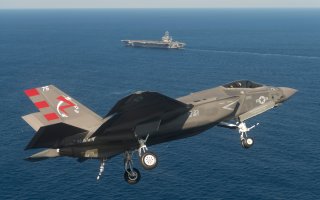How the Marine Corps Plans to Sink Enemy Warships (Using F-35 Stealth Fighters)
A force multiplier.
Key Point: The experimentation with F-35s as aerial observers for rocket strikes underscores how serious the Marine Corps is about hitting targets far away. Including ships.
The U.S. Marine Corps recently proved that an F-35 stealth fighter can pass targeting data to a ground-based rocket launcher.
The test, which took place in Yuma, Arizona sometime prior to mid-October 2018, involved a Marine F-35B detecting a metal container on the ground and passing the GPS coordinates via radio datalink to one of the Corps’s wheeled High-Mobility Artillery Rocket System launcher.
The HIMARS launcher fired a rocket at the coordinates. “We were able to target a particular conex box,” Lt. Gen. Steven Rudder, the Marines’ deputy commandant for aviation, told an audience at a think tank in Washington, D.C. on Oct. 12, 2018.
The test represents the latest expansion of the Marines’ rocket capabilities, which could play a significant role in any future high-intensity conflict. The Corps doubled its spending on HIMARS from $68 million in 2017 to $134 million in 2018.
The extra cash bought additional resupply vehicles for the Marines’ nine HIMARS batteries, each of which possesses six, 12-ton launchers. The Corps is also experimenting with new operating concepts for its rocket force — for example, launching rockets from the flight deck of the assault ship USS Anchorage in October 2017 and, in March 2018, quickly transporting a launcher aboard a C-130 transport plane, firing four rockets, driving back into the plane and flying away.
The Marines are also considering buying an anti-ship missile for its HIMARS launchers. But existing rockets also work against ships. During the Rim of the Pacific war game in and around Hawaii in July 2018, a U.S. Army HIMARS battery struck the decommissioned U.S. Navy amphibious ship Racine with five rockets. An aerial drone provided the coordinates for the 50-plus-mile strike, pictured at top.
The HIMARS’s primary rocket is the Guided Multiple Launch Rocket System, with a 200-pound warhead and a maximum range of 50 miles. A single HIMARS launchers can carry, and launch, six of the GPS-guided GMLRS at a time. The larger Army Tactical Missile System packs bomblets or a 500-pound unitary warhead and can fly as far as 186 miles. A HIMARS can fit one ATACMS at a time.
The Army is developing a new, mid-size rocket with a 310-mile range — two of which can fit in a HIMARS. The Army and Marines are also exploring the possibility of adapting Raytheon’s 100-mile-range Naval Strike Missile to be compatible with HIMARS.
HIMARS packing anti-ship missiles could give the Corps a serious, and seriously survivable, coastal-defense capability. Launchers could “shoot and scoot” to escape counter-fire. “After firing each volley, the missile battery would move to a new hide site and await orders to fire again,” the think-tank RAND explained in a 2017 report.
Long-range rockets require long-range targeting. When the target is a ship at sea, human forward observers aren’t an option. That the Marines are experimenting with F-35s as aerial observers for rocket strikes underscores how serious the Corps is about hitting targets far away. Including ships.
This first appeared in WarIsBoring here. This article first appeared in 2018 and is reprinted here due to reader interest.
Image: U.S. Navy / Flickr

